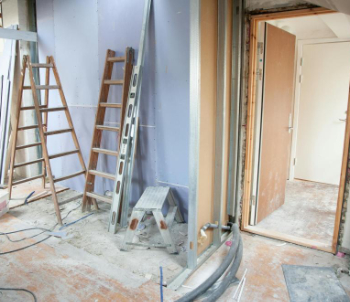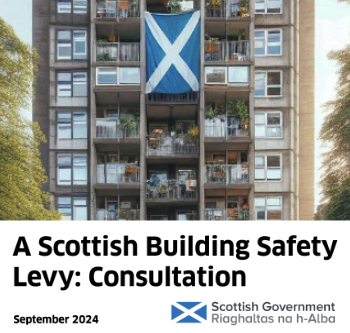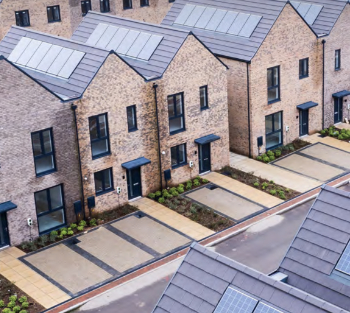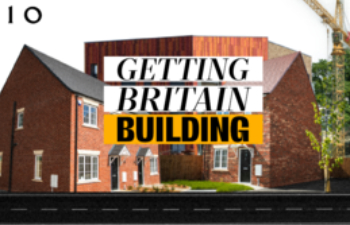Flat roof
Contents |
[edit] Introduction
A flat roof is a roof that is completely, or almost level. However, whilst they are described as ‘flat’ almost all flat roofs are actually laid to a fall to ensure that rainwater can run off to the lower side. Typically they are designed to have a minimum fall of 1:40, which given on-site inaccuracies should result in a minimum fall of at least 1:80 in the finished construction.
This is in contrast with a pitched roof which slopes.
The Scottish Technical Handbook - Domestic, describes flat roofs as roofs, '...the slope of which does not exceed 10º from the horizontal'.
While very common in countries with warm climates, flat roofs were only widely adopted in the UK after the Second World War. They were seen as a cheaper alternative to traditional pitched roofs. However, the longevity of some flat roofs has been poor, ranging from 6 years to 35 years depending on the quality of the covering and the structure.
[edit] Types of flat roof coverings
Common flat roof coverings include:
- Sheet materials such as bituminous felt.
- In situ material materials such as asphalt.
- Metal such as lead or copper.
These roof coverings are generally designed to be laid as flat, continuous sheets, and they are prone to weakness where they are bent; for example at parapets and verges, where they are penetrated by ducts, flues, and so on, and at joints or seams.
[edit] Types of flat roof deck
[edit] Concrete slab flat roofs
A concrete slab flat roof is normally made up of a structural layer of concrete finished with a smooth screed onto which a water proof layer such as a membrane is laid. The roof should incorporate insulation and usually a vapour control layer to protect from interstitial condensation.
[edit] Timber flat roofs
Timber flat roof construction usually consists of structural joists topped with a decking of plywood or a similar sheet material. Wherever possible, joists should span the shortest distance of the roof plan . The pitch is governed by the roof covering and the required rate of rainwater discharge.
There are a number of different possible methods of creating a fall (slope):
- Joists cut to falls with flat soffit: These are simple to fix but may not be very economical in terms of timber usage, unless two joists are cut from one piece.
- Joists laid to falls with sloping soffit: Economic and simple but the sloping soffit may need to be hidden by a flat suspended ceiling.
- Firrings (tapered strips fixed above the joists) with joist run: Simple and effective but it does not provide a means of natural cross ventilation.
- Firrings against joist run: Simple, effective, and provides a means of natural cross ventilation, but uses more timber.
The loadings and span of the flat roof will determine the spacing and sizes of the joists required.
As with concrete flat roofs, a timber construction will be finished with a waterproof covering such as a membrane, or a sheet material such as lead. Insulation will be incorporated within the roof build up, together with a vapour control layer to protect from interstitial condensation.
Garages may be un-insulated, but most roofs above the habitable part of the house will need to be insulated to comply with Building Regulations.
Conservation of energy can be achieved in two ways:
- Cold roof: Insulation is placed on the ceiling lining, between the joists.
- Warm roof: Insulation is placed below the waterproof covering, above the roof decking.
- Inverted roof: Insulation is placed above the waterproof covering.
For more information, see Flat roof defects.
[edit] Related articles on Designing Buildings
- A-frame house.
- Blue roof.
- Cold roof.
- Conical roof slating.
- Cool roofs.
- Domestic roofs.
- Dormer window.
- Firring.
- Flat roof defects.
- Green roofs.
- Inverted roof.
- Long span roof.
- Mansard roof.
- Pitched roof.
- Roofing defects.
- Thatch roofing.
- Types of roof.
- Wall plate.
- Warm roof.
[edit] External references
- ‘Building Construction Handbook’ (6th ed.), CHUDLEY, R., GREENO, R., Butterworth-Heinemann (2007)
Featured articles and news
Considerate Constructors Scheme acquires Building A Safer Future
Acquisition defines a new era for safety in construction.
AT Awards evening 2024; the winners and finalists
Recognising professionals with outstanding achievements.
Reactions to the Autumn Budget announcement
And key elements of the quoted budget to rebuild Britain.
Chancellor of the Exchequer delivers Budget
Repairing, fixing, rebuilding, protecting and strengthening.
Expectation management in building design
Interest, management, occupant satisfaction and the performance gap.
Connecting conservation research and practice with IHBC
State of the art heritage research & practice and guidance.
Innovative Silica Safety Toolkit
Receives funding boost in memory of construction visionary.
Gentle density and the current context of planning changes
How should designers deliver it now as it appears in NPPF.
Sustainable Futures. Redefining Retrofit for Net Zero Living
More speakers confirmed for BSRIA Briefing 2024.
Making the most of urban land: Brownfield Passports
Policy paper in brief with industry responses welcomed.
The boundaries and networks of the Magonsæte.
London Build Fire and Security Expo
20-21 Nov and now with new Ambassador Programme..
The Scottish Building Safety Levy
Eight weeks of consultation closing on 18 November.
The grey, the brown and the golden rules of housing
shifting policies from the wild west of housing development.
Future proofing homes that are fit for purpose
Specification challenges and the role of plastic.
Thousands of new homes unlocked for brownfield sites
£68 million to 54 councils for neglected land into new homes.
























Comments